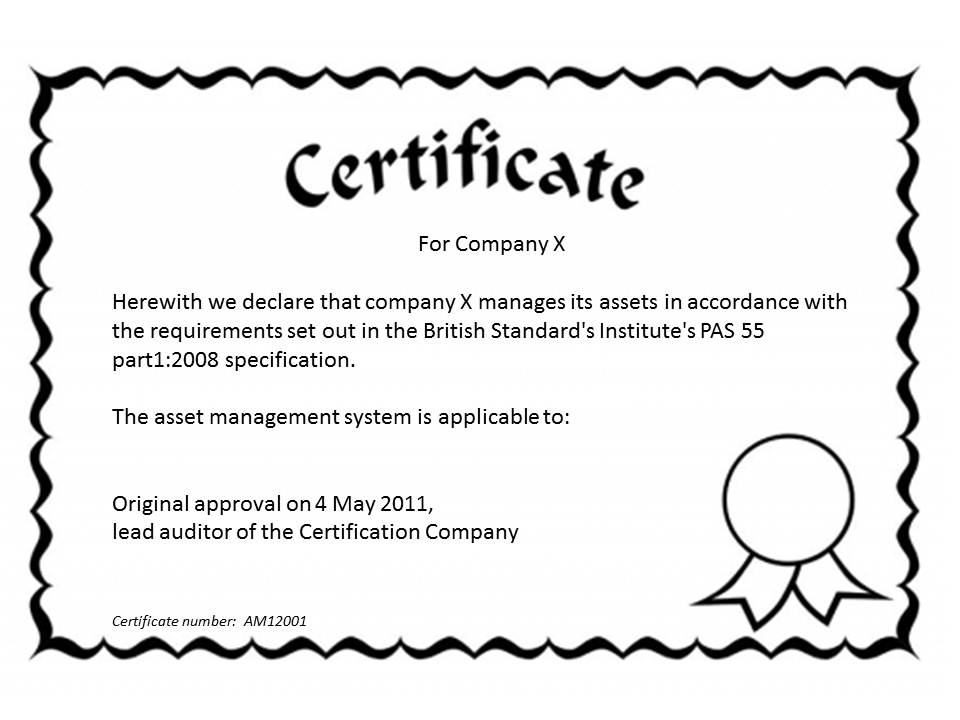Is a PAS55 certified company a capable asset manager?
4 May 2012 • John de Croon
policy development
About 20 years ago, the ISO9000 series became fashionable. In Japan with the help of Deming and Juran they significantly improved their processes. Western industries were overtaken by the superior quality of Japanese products. So Western companies went on to improve their 'quality'. Processes were described and certification bodies had good times. The term 'isoitis' was heard: the certification of quality management systems seemed to be a disease. Some companies were disappointed because the expected results were not achieved. What went wrong?
Known is the story of the Dutch multinational Philips. Philips also suffered from the Japanese competition and thus the customer had to be put centrally. In the '80s the company did a first unsuccessful attempt[1]. Staff went looking for the customer and found it. However, this was often an internal customer and not an external one. Real improvements were not made.
Many other companies also described the processes and certified those. And if you wrote down what you did you could, usually with some adjustments in some supporting processes, become the ISO certificate. So a company has a nice paper on the wall, but the process could still be according to the ´garbage in = garbage out' principle. The ISO certificate was often an end rather than a means (sometimes called ´cold certification´). And that is exactly what the Japanese competition did not do: they wanted to improve the product and that besides their processes met the ISO requirements was a nice bonus.
When years after the first attempt Philips started the marketing campaign “Let's make things better". The Japanese competitor Sony laconically responded with "Let's make better things".
In the first version of the ISO9000 series continual improvement was no hard requirement. So if you produced 'garbage' for consecutive years, with respect to the certificate you could get away with it. Because this is not compliant with the idea of quality and as companies in Japan continued to improve themselves, the response was that the standards of the ISO9000 series are changed with the requirement that an improvement cycle (Plan - Do - Check - Act or PDCA) had to be implemented.
Fortunately, in the creation of PAS55 continuous improvement is explicitly captured (see the figure in section 4.6 of the standard PAS55[2]), making the situation as in the first version of ISO9001 not likely.
However the next question is relevant: if a company currently becomes PAS55 certified, is the company then a good asset manager? In the asset intensive sector, we now see the same at some companies as did happen with the introduction of the ISO9000 series in the 90s of last century. ´We want to be certified within one year according to PAS55 and thus be the best´ is what we hear for example.
Former Yorkshire Electricity (YE, now part of CE Electric) in the United Kingdom was seen as a best-in-class asset manager at the beginning of this century. YE worked intensively on the Macro project in the United Kingdom, from which PAS55 emerged. The first version of PAS55 appeared in 2004. The times we visited YE, we even had the impression that they were a little ashamed of the fact that they had no certificate, but that their owner did not allow spending time on it. Only in 2008 CE Electric was granted the PAS55 certificate, while they already acted 'by the book' for many years. At YE (and now CE Electric) people were already continuously improving their processes and they therefor were an excellent asset manager. The certificate is thus for CE Electric an aptitude test, and they deserve it.

You must realise that if you want to get certified, the continual improvement process will only be marginally validated during the initial certification audit. The real test will occur the next audit round. When a company is PAS55 certified, that does not mean that an optimal value is created for the stakeholders of the asset intensive organization. Even the best practice asset managers see continuous improvement opportunities and achieving the PAS55 certificate is certainly not the end. The order should be the other way around. If you have the asset management process properly organised and systematically execute these and are able to prove it, then the certification is a small effort.
Having a PAS55 certificate should not be confused with practicing proper asset management. Therefore, make sure that you do not get PASsive, because a cold certification will not add the desired value!
[1] See e.g. “In het verleden behaalde resultaten bieden garantie voor de toekomst”, M&O, mei/juni 2010 (in Dutch)
John de Croon is partner at AssetResolutions BV, a company he co-founded with Ype Wijnia. In turn, they give their vision on an aspect of asset management in a weekly column. The columns are published on the website of AssetResolutions, http://www.assetresolutions.nl/en/column
<< back to overview
|


